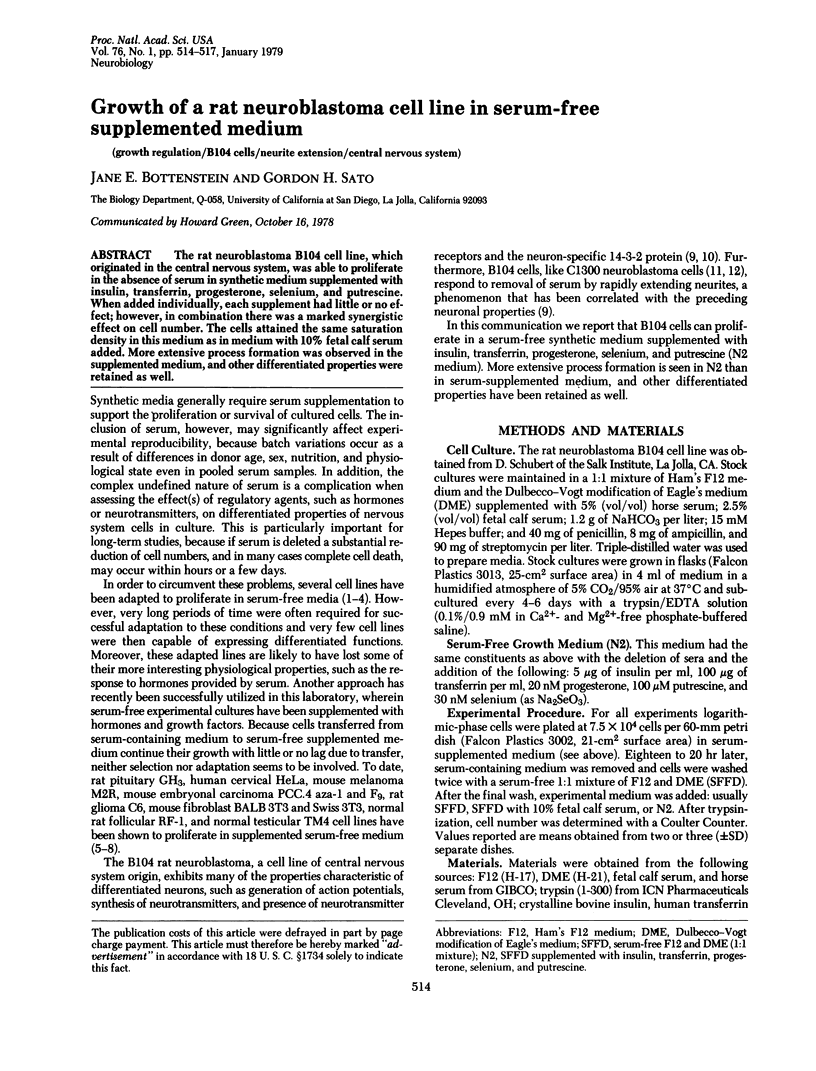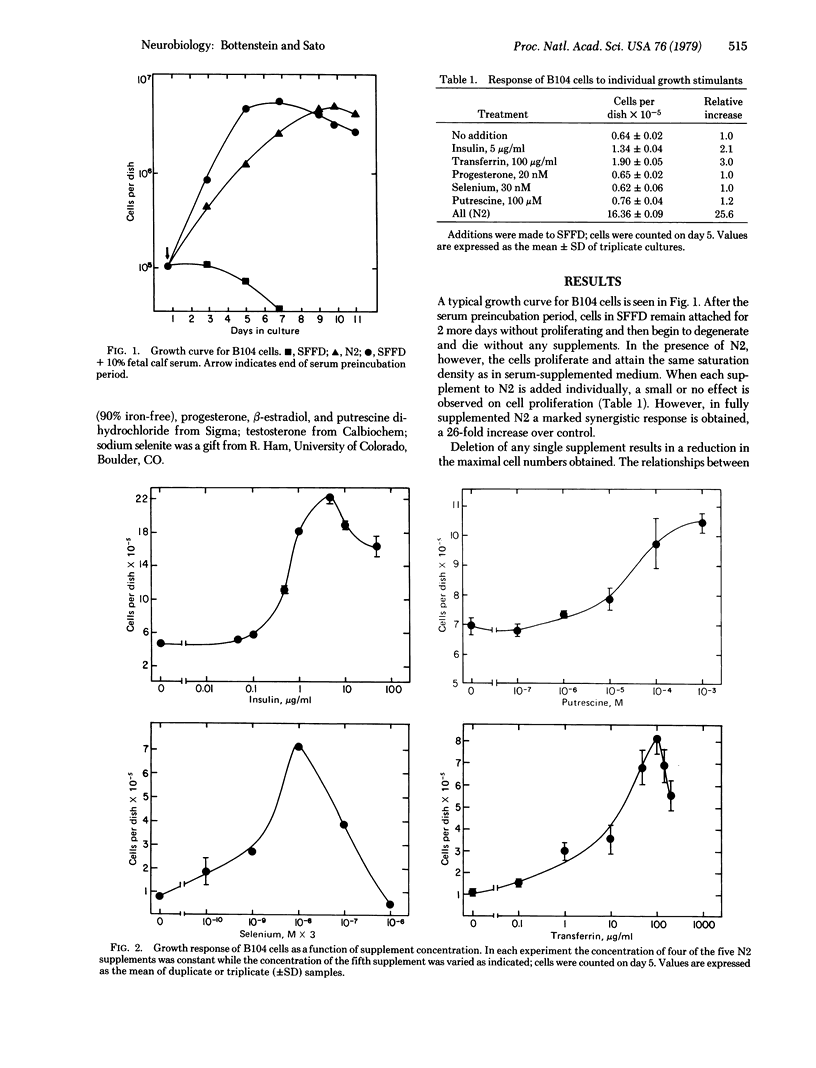Abstract
The rat neuroblastoma B104 cell line, which originated in the central nervous system, was able to proliferate in the absence of serum in synthetic medium supplemented with insulin, transferrin, progesterone, selenium, and putrescine. When added individually, each supplement had little or no effect; however, in combination there was a marked synergistic effect on cell number. The cells attained the same saturation density in this medium as in medium with 10% fetal calf serum added. More extensive process formation was observed in the supplemented medium, and other differentiated properties were retained as well.
Full text
PDF



Images in this article
Selected References
These references are in PubMed. This may not be the complete list of references from this article.
- Augusti-Tocco G., Sato G. Establishment of functional clonal lines of neurons from mouse neuroblastoma. Proc Natl Acad Sci U S A. 1969 Sep;64(1):311–315. doi: 10.1073/pnas.64.1.311. [DOI] [PMC free article] [PubMed] [Google Scholar]
- Bottenstein J., Hayashi I., Hutchings S., Masui H., Mather J., McClure D. B., Ohasa S., Rizzino A., Sato G., Serrero G. The growth of cells in serum-free hormone-supplemented media. Methods Enzymol. 1979;58:94–109. doi: 10.1016/s0076-6879(79)58127-0. [DOI] [PubMed] [Google Scholar]
- Czech M. P. Molecular basis of insulin action. Annu Rev Biochem. 1977;46:359–384. doi: 10.1146/annurev.bi.46.070177.002043. [DOI] [PubMed] [Google Scholar]
- Donta S. T. The growth of functional rat glial cells in a serumless medium. Exp Cell Res. 1973 Nov;82(1):119–124. doi: 10.1016/0014-4827(73)90252-8. [DOI] [PubMed] [Google Scholar]
- EVANS V. J., BRYANT J. C., FIORAMONTI M. C., MCQUILKIN W. T., SANFORD K. K., EARLE W. R. Studies of nutrient media for tissue cells in vitro. I. A protein-free chemically defined medium for cultivation of strain L cells. Cancer Res. 1956 Jan;16(1):77–86. [PubMed] [Google Scholar]
- EVANS V. J., BRYANT J. C., KERR H. A., SCHILLING E. L. CHEMICALLY DEFINED MEDIA FOR CULTIVATION OF LONG-TERM CELL STRAINS FROM FOUR MAMMALIAN SPECIES. Exp Cell Res. 1964 Dec;36:439–474. doi: 10.1016/0014-4827(64)90302-7. [DOI] [PubMed] [Google Scholar]
- Fletcher J., Huehns E. R. Function of transferrin. Nature. 1968 Jun 29;218(5148):1211–1214. doi: 10.1038/2181211a0. [DOI] [PubMed] [Google Scholar]
- Greene L. A., Tischler A. S. Establishment of a noradrenergic clonal line of rat adrenal pheochromocytoma cells which respond to nerve growth factor. Proc Natl Acad Sci U S A. 1976 Jul;73(7):2424–2428. doi: 10.1073/pnas.73.7.2424. [DOI] [PMC free article] [PubMed] [Google Scholar]
- Guilbert L. J., Iscove N. N. Partial replacement of serum by selenite, transferrin, albumin and lecithin in haemopoietic cell cultures. Nature. 1976 Oct 14;263(5578):594–595. doi: 10.1038/263594a0. [DOI] [PubMed] [Google Scholar]
- HERBST E. J., SNELL E. E. Putrescine and related compounds as growth factors for Hemophilus parainfluenzae 7991. J Biol Chem. 1949 Nov;181(1):47–54. [PubMed] [Google Scholar]
- Ham R. G. Putrescine and related amines as growth factors for a mammalian cell line. Biochem Biophys Res Commun. 1964;14:34–38. doi: 10.1016/0006-291x(63)90206-7. [DOI] [PubMed] [Google Scholar]
- Havrankova J., Roth J., Brownstein M. Insulin receptors are widely distributed in the central nervous system of the rat. Nature. 1978 Apr 27;272(5656):827–829. doi: 10.1038/272827a0. [DOI] [PubMed] [Google Scholar]
- Hayashi I., Sato G. H. Replacement of serum by hormones permits growth of cells in a defined medium. Nature. 1976 Jan 15;259(5539):132–134. doi: 10.1038/259132a0. [DOI] [PubMed] [Google Scholar]
- Hutchings S. E., Sato G. H. Growth and maintenance of HeLa cells in serum-free medium supplemented with hormones. Proc Natl Acad Sci U S A. 1978 Feb;75(2):901–904. doi: 10.1073/pnas.75.2.901. [DOI] [PMC free article] [PubMed] [Google Scholar]
- Jiménez de Asúa L., Surian E. S., Flawia M. M., Torres H. N. Effect of insulin on the growth pattern and adenylate cyclase activity of BHK fibroblasts. Proc Natl Acad Sci U S A. 1973 May;70(5):1388–1392. doi: 10.1073/pnas.70.5.1388. [DOI] [PMC free article] [PubMed] [Google Scholar]
- Lajtha A., Sershen H. Substrate specificity of uptake of diamines in mouse brain slices. Arch Biochem Biophys. 1974 Dec;165(2):539–547. doi: 10.1016/0003-9861(74)90280-x. [DOI] [PubMed] [Google Scholar]
- McKeehan W. L., Hamilton W. G., Ham R. G. Selenium is an essential trace nutrient for growth of WI-38 diploid human fibroblasts. Proc Natl Acad Sci U S A. 1976 Jun;73(6):2023–2027. doi: 10.1073/pnas.73.6.2023. [DOI] [PMC free article] [PubMed] [Google Scholar]
- Messmer T. O. Nature of the iron requirement for Chinese hamster V79 cells in tissue culture medium. Exp Cell Res. 1973 Mar 15;77(1):404–408. doi: 10.1016/0014-4827(73)90594-6. [DOI] [PubMed] [Google Scholar]
- Phillips M. E., Coxon R. V. Effect of insulin and phenobarbital on uptake of 2-deoxyglucose by brain slices and hemidiaphragms. J Neurochem. 1976 Aug;27(2):643–645. doi: 10.1111/j.1471-4159.1976.tb12299.x. [DOI] [PubMed] [Google Scholar]
- Pohjanpelto P. Putrescine transport is greatly increased in human fibroblasts initiated to proliferate. J Cell Biol. 1976 Mar;68(3):512–520. doi: 10.1083/jcb.68.3.512. [DOI] [PMC free article] [PubMed] [Google Scholar]
- Pohjanpelto P., Raina A. Identification of a growth factor produced by human fibroblasts in vitro as putrescine. Nat New Biol. 1972 Feb 23;235(60):247–249. doi: 10.1038/newbio235247a0. [DOI] [PubMed] [Google Scholar]
- Rizzino A., Sato G. Growth of embryonal carcinoma cells in serum-free medium. Proc Natl Acad Sci U S A. 1978 Apr;75(4):1844–1848. doi: 10.1073/pnas.75.4.1844. [DOI] [PMC free article] [PubMed] [Google Scholar]
- Rudland P. S., Durbin H., Clingan D., de Asua L. J. Iron salts and transferrin are specifically required for cell division of cultured 3T6 cells. Biochem Biophys Res Commun. 1977 Apr 11;75(3):556–562. doi: 10.1016/0006-291x(77)91508-x. [DOI] [PubMed] [Google Scholar]
- Schubert D., Carlisle W., Look C. Putative neurotransmitters in clonal cell lines. Nature. 1975 Mar 27;254(5498):341–343. doi: 10.1038/254341a0. [DOI] [PubMed] [Google Scholar]
- Schubert D., Heinemann S., Carlisle W., Tarikas H., Kimes B., Patrick J., Steinbach J. H., Culp W., Brandt B. L. Clonal cell lines from the rat central nervous system. Nature. 1974 May 17;249(454):224–227. doi: 10.1038/249224a0. [DOI] [PubMed] [Google Scholar]
- Schubert D., Humphreys S., Jacob F., de Vitry F. Induced differentiation of a neuroblastoma. Dev Biol. 1971 Aug;25(4):514–546. doi: 10.1016/0012-1606(71)90004-2. [DOI] [PubMed] [Google Scholar]
- Seeds N. W., Gilman A. G., Amano T., Nirenberg M. W. Regulation of axon formation by clonal lines of a neural tumor. Proc Natl Acad Sci U S A. 1970 May;66(1):160–167. doi: 10.1073/pnas.66.1.160. [DOI] [PMC free article] [PubMed] [Google Scholar]
- Seiler N., Lamberty U. Interrelations between polyamines and nucleic acids: changes of polyamine and nucleic acid concentrations in the developing rat brain. J Neurochem. 1975 Jan;24(1):5–13. doi: 10.1111/j.1471-4159.1975.tb07621.x. [DOI] [PubMed] [Google Scholar]
- Stadtman T. C. Selenium biochemistry. Science. 1974 Mar 8;183(4128):915–922. doi: 10.1126/science.183.4128.915. [DOI] [PubMed] [Google Scholar]
- Takaoka T., Katsuta H. Long-term cultivation of mammalian cell strains in protein- and lipid-free chemically defined synthetic media. Exp Cell Res. 1971 Aug;67(2):295–304. doi: 10.1016/0014-4827(71)90412-5. [DOI] [PubMed] [Google Scholar]
- Temin H. M. Studies on carcinogenesis by avian sarcoma viruses. VI. Differential multiplication of uninfected and of converted cells in response to insulin. J Cell Physiol. 1967 Jun;69(3):377–384. doi: 10.1002/jcp.1040690314. [DOI] [PubMed] [Google Scholar]



